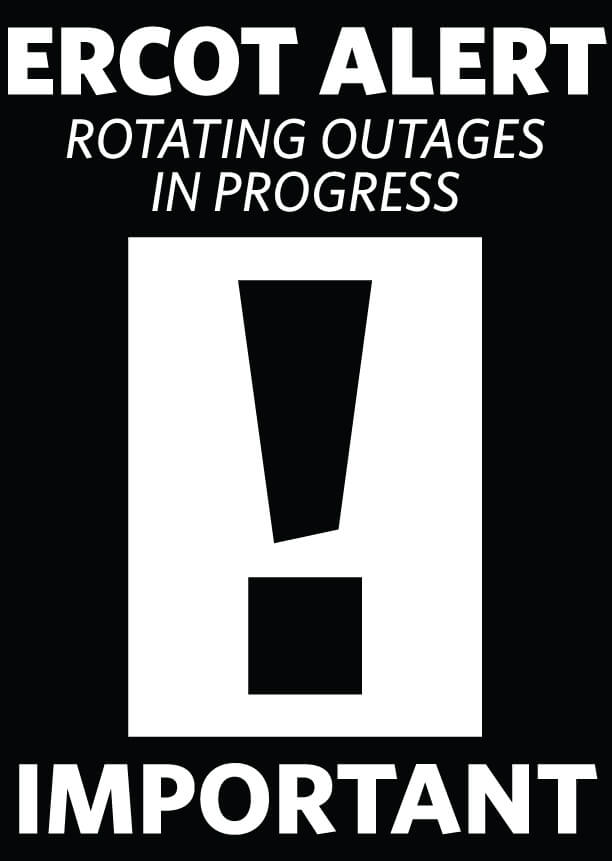ERCOT
The Electric Reliability Council of Texas (ERCOT)
manages the flow of electric power to more than
25 million Texas customers – representing about
90 percent of the state’s electric load.
The Electric Reliability Council of Texas (ERCOT)
manages the flow of electric power to more than
25 million Texas customers – representing about
90 percent of the state’s electric load.
During summer and winter, electricity usage across the state is at its highest. This is why ERCOT is most likely to issue Energy Alerts during these times of year. If you’re unfamiliar with ERCOT and ERCOT Alerts or why you need to be aware of them, the FAQs on this page are a great way to learn more. You can also find additional information about ERCOT by visiting their website at ercot.com. We also regularly write about ERCOT in the Texas Co-op Power Magazine and on MVEC Social Media.
ERCOT stands for the Electric Reliability Council of Texas. It is an independent electric-system operator, managing most of the Texas electric grid. ERCOT is governed by a board of directors, with oversight by the Public Utilities Commission of Texas and the State Legislature. Its members include consumers, and electricity generators, marketers, and providers. “Providers” include transmission and distribution specialists, investor-owned utilities, public-owned municipal utilities and cooperatives like MVEC.
ERCOT manages the power supply to over 25 million Texas electric customers. It schedules and regulates electricity across a grid of 46,500 miles of transmission line and more than 650 generation units, balancing supply and demand in real time. ERCOT manages around 90 percent of our statewide electric load. It’s not incorrect to think of this agency as both gatekeeper and warden of the Texas power grid.
ERCOT works 24 hours a day, 365 days a year to make sure the amount of power consumed on the grid never equals or exceeds total generation capacity. When there’s an imbalance at the local level, ERCOT works with generators and suppliers to make sure the difference is financially “settled.”
Every year, in advance of summer, ERCOT takes inventory of statewide generation capacity. From this assessment, the agency creates a forecast of how much total electricity generation will be possible across the grid, all at once, during day-to-day operations around the state. The agency also strives to maintain its reserve capacity each year at 13.75 percent of estimated peak usage.
Throughout the state, summer is a time of intense electric usage, especially through the week, between 3 and 7 p.m. In addition to this being the hottest part of the day, it’s also when people are arriving home from work and school and are cranking down the AC, turning on the TV, starting dinner, running the dishwasher and so forth.
Power shortages between generators and suppliers do happen across the Texas grid. High energy demand at the local level usually don’t have much impact statewide; however, an all-at-once spike in demand across the Texas grid that approaches or exceeds total, statewide capacity can have serious consequences for availability. Such spikes are a very real threat during the height of Texas summer. One of ERCOTS’s most important tools for helping restrain summertime usage across the grid is known as the four coincidental peaks (4CP).
The 4CPs occur one per month every June, July, August and September. These peaks happen when demand for electricity across the statewide grid reaches its highest point. ERCOT bases the next year’s share of transmission costs for each Texas provider on the provider’s share of grid demand during these four peaks. It’s important, then, for each consumer within a provider’s territory to restrain usage as much as possible during 4CPs to keep rates down.
As a way to help our members reduce usage during the 4CPs, MVEC has partnered with Nest® to offer Rush Hour Rewards, our latest and most rewarding peak-time usage program. For more information on how you can help reduce MVEC’s overall grid demand during ERCOT’s 4CPs—and get paid doing it—visit our Rush Hour Rewards page.
ERCOT does have plans in place, including a reserve power supply, in the event that statewide power consumption comes close to equaling or surpassing what’s generated and delivered. The agency’s system is made up of a preemptive Conservation Alert and three Energy Emergency Alerts (EEA). These alerts increase in severity with each new level.
Conservation Alert

Yellow graphic with black text show the ERCOT conservation alert. At this level, ERCOT aims to raise public awareness about shrinking reserves and the need to actively conserve energy to prevent emergency conditions.
Emergency Alerts

Level 1: The first EEA level is Conservation Needed. ERCOT issues this alert when operating reserves drop below a target threshold. This level puts providers on notice to take preliminary measures to curb demand before the situation worsens.

Level 2: If conditions worsen, ERCOT will next issue an EEA Level 2 – Conservation Critical. At this level, providers are permitted to reduce their power load by interrupting supply to large commercial and industrial accounts. The contracts these clients sign stipulate that such measures may be necessary in an emergency.

Level 3: If power supply declines further, ERCOT will then declare an EEA Level 3 – Rotating Outages in Progress, the final alert level. At this level, ERCOT will require electricity providers throughout the state to begin introducing temporary outages at the local distribution level—also known as rolling brownouts or rotating outages.
Rotating outages are temporary, controlled interruptions of service. They typically last 15-45 minutes. During these outages, service is interrupted within only one section of a local grid at a time before rolling on to another section. The need for rotating outages across the Texas energy grid are rare. ERCOT has mandated them only three times in its entire history.
The answer here is more complicated than the question implies. The three biggest drivers behind shortages in state energy reserves are the economy, population growth, and changes in the energy market itself.
In the last decade, solar and wind power have emerged as a serious force in the energy marketplace, driving electricity prices steadily downward. Natural gas has also become a factor in energy prices in certain places around the country, including in the ERCOT North hub. New technologies have driven energy prices so low, in fact, that investing in new generation assets has become less economically practical for producers. Many companies are either delaying or canceling new generation projects until the market becomes more favorable.
These market factors, combined with Texas’ ongoing economic and population growth, have created an environment where electricity demand significantly increases each year at a pace faster than reserve energy can be generated. It’s important to note that, no matter how much power that suppliers purchase from their producers, it’s impossible to fill the demand if total generation and reserve capacity across the statewide grid can’t keep up with what consumers use.
How can I help conserve?
Use fans when you’re home, but turn them off when you leave the room. Although fans don’t lower the room temperature, they make your skin feel 4 to 6 degrees cooler, allowing you to set your thermostat temperature higher.
Set thermostats 2 to 3 degrees higher, from 3 to 7 p.m. MVEC recommends setting your thermostat to 78 degrees during the summer or to the highest possible temperature you can tolerate.
You can help lessen strain on the grid during peak times by running your pool pump outside the 3 to 7 p.m. time frame.
Avoid using large appliances during peak time, which is between 3 and 7 p.m.
Close curtains and blinds during the hottest part of the day. Doing so helps prevent heat gain through your windows, improving energy efficiency.
Wash your clothes in cold water. By some estimates, up to 30 percent of a home’s energy bill comes from the water heater.
Dry clothes in the morning or overnight, after the 3 p.m. – 7 p.m. peak window.
Many current electronic devices continue using power even after the power button is switched to the off position. Coffeemakers, computers, gaming consoles, smart TVs and more fall into this category. Generally, if a device has a power indicator light that remains on even when the device is powered off, it is still draining electricity. We recommend plugging energy vampires into a power strip. This way, you can turn them all off at once with a flick of the switch.
In addition to lowering an HVAC system’s energy efficiency, a dirty AC filter can cause lots of problems, including increased wear and tear on the system, uneven cooling and more.